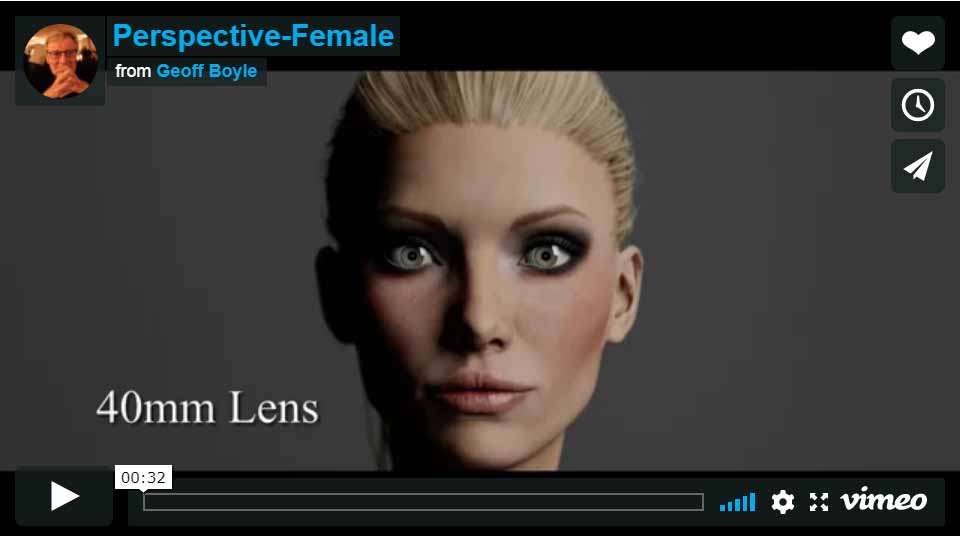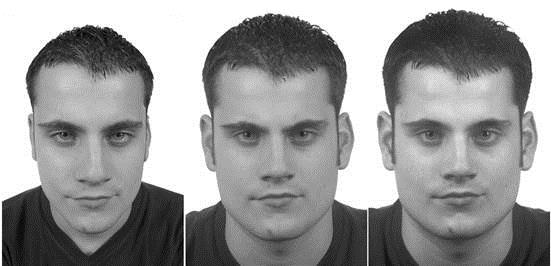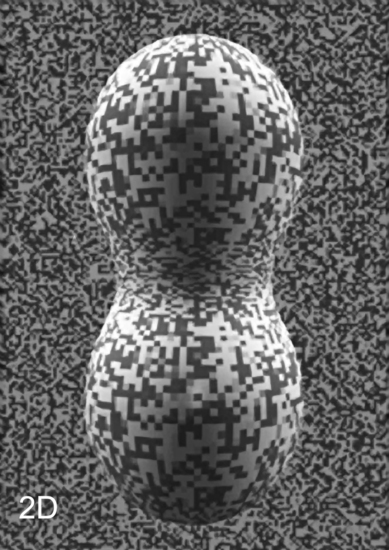The Imperfect Image:
How Professional Photography Makes Slim People
Look Overweight
Lens Aberration: “An image defect caused by a lens’s inability to form a perfect image”
PhD citation: “In a classic paradigm for doctoral research, Harper has noticed a phenomenon of visual perception and asked for an explanation. Though widely believed, the phenomenon that people look fatter in photographs has never been put to experimental test. In a series of experiments with natural and artificial objects, he established the phenomenon to be true……….The examiners were impressed by his findings and feel that they make an original contribution to the science of visual perception, experimentally verifying what was until now only folklore.”
Professor Jules Davidoff* & Dr Georg Meyer**
“This thesis reveals a new perceptual effect and makes every photographic text book look out of date.”
John Watkinson F.A.E.S***
B.I.D. The 3D Secret in Every 2D Portrait
Does a secret aberration lie in every 2D photograph of a human face? Is perfect 2D photography of a real 3D face even possible? In a series of experiments, slim 18 year-old females (example above) looked overweight to almost all 60 people viewing their portraits, regardless of what lens was used. Yet males (shown below) are all unfattened by the same range of professional wide-angle to telephoto lenses. How is that possible? Portraits of healthy students were shown, the lightest subjects being the lowest ethically allowable in any study. Yet the females were all seen as significantly overweight, while the male group were judged as slightly underweight in identical conditions. Can photography ever be an ethical method record if body distortions are always created, but never corrected? Can any lens-based imagery ever perfectly represent our visual reality?
As Dr Bernard Harper reveals, these previously unmeasured distortions of size and shape can have profound ethical and practical implications for filmmakers, photographers, female models, camera designers, AI/Facial recognition/ID imaging systems, on-screen talent, and people of colour. How is it possible that after over 200 years of photographic research, an imaging imperfection leading to major perceptual distortions could hide in plain sight?
The Body Image Distortion effect has been reproduced
in CGI by Cinematographer Geoff Boyle NSC FBKS

The implications for photographers are discused here:
BID: The Hidden Aberration in 2D Imaging
Aberration: “A defect or imperfection of an optical image caused by inabilities of a lens system to form a perfect image.”
What do we mean by a “perfect” image? And is it really possible that almost 180 years after the invention of modern photography, there can be any photographic aberrations left undiscovered?
This website details the first investigations into the hidden perceptual distortions in seemingly perfect 2D photography. Professional lenses are highly corrected for aberrations in resolution, colour and curvilinear distortions. Theoretically, these lenses record should subjects with the lowest possible deviations from nature (along their X and Y axis). But Z-Axis depth information is discarded in 2D photography. Our infinitely deep 3D reality is compressed into an infinitely small 2-dimensional perspective that can only approximate human binocular vision.
No compression system is lossless. So what is lost in 2D?
True shape and size information is lost in 2D.
The Body Image Distortions measured in these experiments were not minor photographic effects: Extensive aberrations of shape and size perception giving large fattening effects were found to be highly significant and in all of the 2D experiment portraiture.
There is a simple explanation for the observed flattening and fattening effects:
A single lens cannot capture the way people see the real world with their active binocular vision. Five feasibility studies and eight experiments revealed that males are often flattered or masculinized in 2D, whereas females are always fattened. No such effects were found in 3D.
The most strongly evident 2D effect was a significantly fattened face and form perception in all of the female portraits. Even the slimmest females are excessively fattened under identical conditions to the male subjects, regardless of the methods of reproduction.
Distance Increases Distortion


These three portraits are from a five photo range. They were taken with increasing camera-to-subject distances using Wide-angle (left), Standard (centre) and Telephoto (right) prime lenses. The eye sizes and InterPupillary Distances are identically scaled in each image. As can be seen, head & neck sizes change dramatically with distance. But the data shows that the males never suffered from the same flattening and fattening effects as the females in any of the 2D portraits
- Disturbingly, the most underweight females always received the most overweight body size estimations.
- The highest female overweight estimations were found with the most common focal lengths and camera-to-subject distances used in professional photography.
- The fattening effect averaged at over 10% of total body weight for females, but was zero for males.
- Differences in the way we perceive widened Jaw-Neck and Waist-Hip ratios in male and female images seems to explain the gender effects
These counterintuitive findings are revealed and explained in detail here for the first time. No previous experiments have ever been done on these phenomena. So there are no preexisting academic references that can give a wider experimental context to this research. Every experiment made on Body Image Distortion in Photography was conducted by this experimenter and is reported here. The website presents extensive evidence to support the claims that increasing camera to subject distances (going from wide-angle to telephoto) increases size estimations. 3D portraiture however compensates for flattening and fattening effects of 2D imaging and can give remarkably lifelike and accurate imaging.
Eight experiments using original photography of over 200 participants investigated monocular size and gender distortions in the perception of almost every type of 2D photographic image. Each are explained using lecture material and new data. These effects can only seen in photographs, and are described and discussed in detail on this website, and revealed with their full methodology and data in this PhD Thesis: http://europepmc.org/abstract/eth/433029
The results of the three 2D and five 3D experiments conducted by Dr Bernard Harper between 1999 and 2015 are reviewed, along with new theories, real examples and data.
The experiments revealed new findings of the highest statistical significance. These effects are found at all levels of amateur and professional photography. The research explores the optics and psychology of face, neck and body perception. The photography in each experiment used identical lighting and professional prime lenses in matched stereo pairs. Each experiment was designed to correct for subject differences, experimenter bias and optical variations between lenses, subjects, settings or different methods of reproduction.
The reporting ends by discussing real world issues these effects have in professional practice and the many practical and ethical outcomes stemming from this research.
Summary:
A new photographic aberration is identified: All 2D cameras will convey significant size distortions simply because they are not 3D. 2D cameras cannot actively correct for losing 3D, inevitably creating the most unwanted distortion of them all: Body Image Distortion.
Stereo 3D Reveals True Shape & Size
 This Computer Generated Image peanut shape was projected life-size in stereoscopic 3D and bi-ocular 2D using twin projectors. It is shown here slimming from its actual 2D shape to its mean perceived shape in 3D. Stereoscopic size estimations are always smaller. Much smaller
This Computer Generated Image peanut shape was projected life-size in stereoscopic 3D and bi-ocular 2D using twin projectors. It is shown here slimming from its actual 2D shape to its mean perceived shape in 3D. Stereoscopic size estimations are always smaller. Much smaller
The stereoscopic image capture and projection methodologies used throughout were assessed by Dr Nick Lodge, director of research at the Independent Television Commission and Professor Brian Rogers, the author of the vision science “bibles” Seeing in Depth, Perceiving in Depth and Binocular Vision & Stereopsis. The real-world implications of the resulting research are discussed, with recommendations made on how adverse effects can be reduced. Researchers who conducted subsequent 2D and 3D experiments in this field found the effect to be robust and highly predictable. They could not find any experiments predating the phenomena identified, so they called them“Harper Effects”.
For more information, please contact bernieharper@gmail.com
* Professor Jules Davidoff is a leading experimental psychologist and Director of the Centre for Cognition, Computation and Culture at Goldsmiths University. He was the external Ph.D examiner for this research.
** Dr Georg Meyer was the examiner for the School of Psychology at Liverpool University. He specialises in multisensory perception and objective measures in multi-sensory systems, together with the systematic evaluation of subjective and objective measures of perception.
*** John Watkinson is a Fellow of the Audio Engineering Society, and the leading Focal Press technical author with over 30 best-selling audio visual publications and text books. He is the inventor of state-of-the-art AV technologies and was kind enough to proofread the B.I.D. PhD thesis before its final submission.
“If I had seen this effect before we designed the NASA 720P camera,
I would not have said its 2D image was as good as 3D.”
Richard Jay Solomon****
**** Richard Jay Solomon Was the project leader on the 1997 MIT Polaroid 720P 60 and (and later 72fps) HDTV cameras, which were originally commissioned by DARPA to record NASA shuttle launches. Its design was many years ahead of commercial HD cameras. The MIT team were free to decide its design, and an extensive search could not find any research ascribing any perceptual utility for 3D imaging. So his team designed and built the finest digital 2D video camera in the world and a matching DMD projector to progressively display its 60 to 72 fps imagery. However after seeing the 3D BID images from this research at the Presence Conference in Delft Holland, he agreed the naturalistic stereography used in these experiments did have significant perceptual advantages over 2D imaging, and a 3D pairing of two of his HD cameras was proposed for a later Naval Research project. In a continuation of his 2D HDTV projects, he is now the Chief Scientist on CTech’s research project to develop a novel, wave-based, full-spectrum imaging sensor, spectrometer, and full-spectrum display. These projects were sponsored by the U.S. Office of Naval Research (ONR), Defense Advanced Research Projects Agency (DARPA), Naval Research Lab, NASA, and the National Security Agency.
Bernard Harper PhD bernieharper@gmail.com
Views: 297
